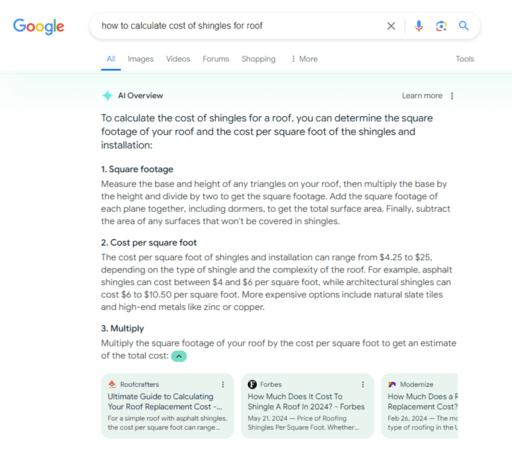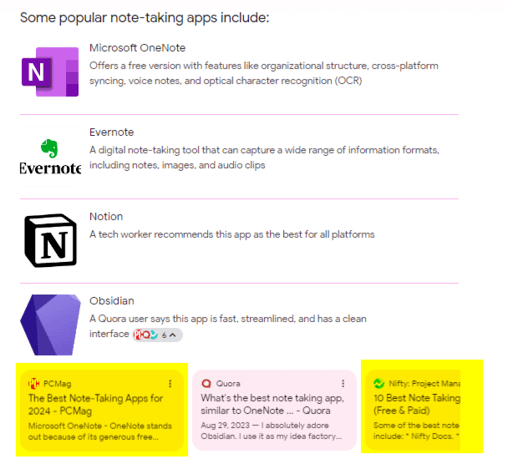-
 Published: May 23, 2024
Published: May 23, 2024
-
 8 min. read
8 min. read
-
 Sarah Berry
Sarah Berry Lead Web Marketing Consultant
Lead Web Marketing Consultant
- Sarah Berry is a Lead Web Marketing Consultant at WebFX. With more than 10,000 hours of experience, she offers practical insights and strategies you can use to grow your digital revenue. When she isn’t polishing her Time Magazine Person of the Year Award, she’s spending time with her flock of ducks.
Google’s AI Overviews (formerly Search Generative Experience or SGE) are here, and if you want to rank in these AI-powered search results, you need to start optimizing for Google’s AI-powered snapshots.
Keep reading to learn how to rank in SGE with our award-winning team’s strategies!
9 most effective tactics for how to rank in SGE
The most effective tactics for how to rank in SGE include the following:
- Practice search engine optimization (SEO)
- Get into Google Knowledge Graph
- Target qualified long-tail searches
- Improve content readability
- Build supporting visuals
- Leverage structured data
- Use Google Merchant Center
- Enhance E-E-A-T signals
- Get featured on third-party sites
Learn how to bring them to your SGE strategy below:
1. Practice search engine optimization (SEO)
Experiments continue to show that websites practicing search engine optimization — and doing it well — have a better chance of appearing in Search Generative Experience or AI Overview snapshots. Google also states that SGE is “rooted in our core Search ranking and quality systems.”
Those core ranking and quality systems include the following:
- BERT
- Crisis information systems
- Deduplication systems
- Exact match domain system
- Freshness systems
- Helpful content system
- Link analysis systems
- Local news systems
- MUM
- Neural matching
- Original content systems
- Removal-based demotion systems
- Passage ranking system
- RankBrain
- Reliable information systems
- Reviews system
- Site diversity system
- Spam detection systems
Follow SEO best practices, and you’ll naturally align with systems like the Spam detection systems.
Where we recommend focusing SGE optimization efforts is on content-based systems, like:
- Freshness systems
- Helpful content system
- Original content systems
- Passage ranking system
- Link analysis systems
For example, optimizations in these areas can include:
- Updating outdated content for still-relevant topics
- Producing original content, like research studies or helpful tools, to attract backlinks
- Making content easier for users (and AI models) to read and understand
- Improving content trust signals with quotes from practitioners, first-party insights, and more
As a disclaimer — don’t ignore SEO best practices outside content-based optimizations. For example, technical SEO is critical to search engines like Google crawling and indexing your content. However, sites with a strong SEO program will find most of their SGE optimizations target content.
2. Get into Google Knowledge Graph
AI Overviews include citations, and Google Knowledge Graph is a popular citation source. This database gives the large language models (LLMs) powering Search Generative Experience billions of data points to use for AI-generated results.
Getting into Google Knowledge Graph isn’t like getting a Google Business Profile — you can’t just apply for one. Instead, you must get Google to recognize your business as an entity. Then, it’ll generate a Google Knowledge Panel.
For the above to happen, there are a few tactics businesses use, including:
- Having a homepage or “About Us” page on your site
- Creating social media profiles, like on Facebook, Twitter, and LinkedIn
- Using Organization schema markup on your website
- Linking to your homepage or “About Us” page from your social profiles
- Attracting external backlinks from other reputable sites in and outside your industry
Depending on your business, you might already have a Google Knowledge Panel! Search your brand name on Google Search and see if a right-hand panel appears. If it does, proceed through the steps for claiming your Google Knowledge Panel.
3. Target qualified long-tail searches
Note: You won’t find suggested follow-up searches in AI Overviews. Google experimented with these suggestions, though, which means they could make a return and become an optimization tool.
Google designed AI Overviews to deliver snapshots that “serve as a jumping-off point” so users can explore topics deeper through cited links or suggested conversational follow-up searches.
Take the search, “how to calculate cost of shingles for roof.”

The AI Overview cites several guides, which cover topics like:
- How much does a roof cost
- How much does a roof cost [in a specific state]
- How to know when to replace a roof
- How to save on roofing costs
From the cited links, your business could produce a new (or updated) guide on the cost of a shingled roof. You could even create an interactive cost calculator tool — tools are great for capturing traffic from AI Overviews!
4. Improve content readability
As a generative search engine, AI Overviews use LLMs like Gemini, MUM, and PaLM2 to power its results. You need to ensure these LLMs can understand your content and its context, which is where improving readability comes into play as a strategy for how to rank in SGE results.
With a free tool like our Readability Test Tool, it’s easy to get started with this optimization.

Enter your URL or text, and the tool will calculate your content’s readability. We recommend an eighth-grade reading level for web content, though this can vary based on your target audience.
5. Build supporting visuals
Visuals are another powerful strategy for ranking in AI-powered snapshots and responding to SGE’s impact on Google Search results. That’s because multimedia elements, from infographics to videos, provide an alternative to text-based results.
AI Overviews, for example, don’t exist in Google Image or Google Video search.
Lean into image SEO and video SEO, and your business can create a new outlet for generating organic traffic since it’s expected to decrease with Google’s AI-powered results.
Visuals are still useful for ranking in SGE results because AI Overviews will include images (and links to the sites hosting them) when relevant. For example, search for “outdoor patio types,” and the snapshot will have visuals.

While the above are photographs, AI Overviews can also include graphics.
Get ideas for what visuals to include using Google Image search or AI-generated results. Think about what would be helpful for your target buyer when searching your target keyword, too.
Even if it doesn’t exist, that doesn’t mean it wouldn’t be helpful!
6. Leverage structured data
Structured data is another effective tactic for how to rank in Search Generative Experience. That’s because structured data provides AI models with valuable information about your content and brand.
Product markup, for instance, provides Google Shopping Graph with information like:
- Price
- Inventory
- Ratings
- And more
AI Overviews use Google Shopping Graph — Google states it “is built on Google’s Shopping Graph” — to generate results, especially results with a transactional search intent like “outdoor patio set.”

Other markup types worth considering include Organization and LocalBusiness.
7. Use Google Merchant Center
Besides referencing content from Google’s index, Google Shopping Graph also uses Google Merchant Center, which AI Overviews then use when generating AI-powered results.
If relevant to your business, join Google Merchant Center, which is free.
8. Enhance E-E-A-T signals
Studies into generative search engines like AI Overviews show that E-E-A-T indicators influence the engines. While E-E-A-T is not a ranking factor, it ties into the goal of Google’s Helpful content system (which is an SGE ranking factor).
E-E-A-T stands for Experience, Expertise, Authority, and Trust and can be improved by:
- Including trust signals, like certifications, awards, or years of experience
- Supporting statements with studies, statistics, or quotes from trusted sources
- Using an authoritative tone of voice, like “Restart the computer” vs. “You should restart the computer.”
In a recent generative engine study, researchers found that the above updates could trigger over a 100% improvement in visibility. Besides improved visibility, better E-E-A-T can impact other important business metrics, like conversion rates for product purchases or quote requests.
9. Get featured on third-party sites
You can also rank in AI-powered snapshots — indirectly — through third-party sites. Consider searches containing “best” or “top,” for example. These searches often feature sites that compile and review products, services, and businesses.

In the example above, frequently-mentioned products get highlighted (though Google doesn’t link to the brand’s website — only the website hosting the image). However, if users opt to visit one of the cited sites, your business has a chance at receiving referral traffic.
Getting featured on third-party sites is like link building with conducting outreach. Like link building, though, these features can happen naturally through word-of-mouth and as your brand grows. You can also join directory sites, like Yelp and Angi’s, and work on attracting reviews there.
Start ranking in AI Overviews
AI Overviews are here, and while Google is still refining their frequency, appearance, and features, the company appears committed to bringing AI to its search results.
So, get started with the SGE ranking tips above now!
Need experts? Contact us online to learn how our AI Overview optimization services can help!
FAQs
Get answers to common AI Overviews (formerly Search Generative Experience) questions below:
What is Search Generative Experience?
According to Google, Search Generative Experience is a “new way to search with generative AI” by providing AI-powered snapshots in Google Search that provide users with quick overviews and options for conversational follow-ups. SGE launched as AI Overviews in May 2024.
Why is Google’s Search Generative Experience important?
Google’s Search Generative Experience is important because of its anticipated impact on organic search. Now that AI Overviews are a part of Google Search, SEOs anticipate it will decrease organic traffic, which will affect other organic metrics, like revenue.
What determines AI Overview rankings?
The following determines your AI Overview rankings:
- AI models
- Core ranking systems for Google Search
- Databases
- Topic
- Search intent
- Multimedia
- Structured data
Optimizing for these ranking factors can improve your SGE rankings.
-
 Sarah Berry is a Lead Web Marketing Consultant at WebFX. With more than 10,000 hours of experience, she offers practical insights and strategies you can use to grow your digital revenue. When she isn’t polishing her Time Magazine Person of the Year Award, she’s spending time with her flock of ducks.
Sarah Berry is a Lead Web Marketing Consultant at WebFX. With more than 10,000 hours of experience, she offers practical insights and strategies you can use to grow your digital revenue. When she isn’t polishing her Time Magazine Person of the Year Award, she’s spending time with her flock of ducks. -

WebFX is a full-service marketing agency with 1,100+ client reviews and a 4.9-star rating on Clutch! Find out how our expert team and revenue-accelerating tech can drive results for you! Learn more
Try our free Marketing Calculator
Craft a tailored online marketing strategy! Utilize our free Internet marketing calculator for a custom plan based on your location, reach, timeframe, and budget.
Plan Your Marketing Budget
Table of Contents
- How to rank in SGE
- 1. Practice search engine optimization (SEO)
- 2. Get a Google Knowledge Graph
- 3. Target qualified long-tail searches
- 4. Improve content readability
- 5. Build supporting visuals
- 6. Leverage structured data
- 7. Use Google Merchant Center
- 8. Enhance E-E-A-T signals
- 9. Get featured on third-party sites
- Start ranking in SGE results
- FAQs

SEO Success with KOA

Proven Marketing Strategies
Try our free Marketing Calculator
Craft a tailored online marketing strategy! Utilize our free Internet marketing calculator for a custom plan based on your location, reach, timeframe, and budget.
Plan Your Marketing Budget
What to read next





